(Zaman Al Wasl- Exclusive)- During the period that following the announcement of the Caliphate in June 2014, several studies emerged focused on the Islamic State’s economic structure, the most significant resources the Islamic State depends on to fund its operations and cover its expenditures, and the salaries of local or foreign fighters.
Most of the studies concentrated on the generalities of the resources that feed the Islamic State’s economy extending over vast parts of Syria and Iraq. Intelligence actors estimated that after taking control of Mosul, the Islamic State’s budget reached around one billion US dollars as the Islamic State took hold of important oil locations and confiscated tens of millions of US dollars from the Iraqi state treasury.
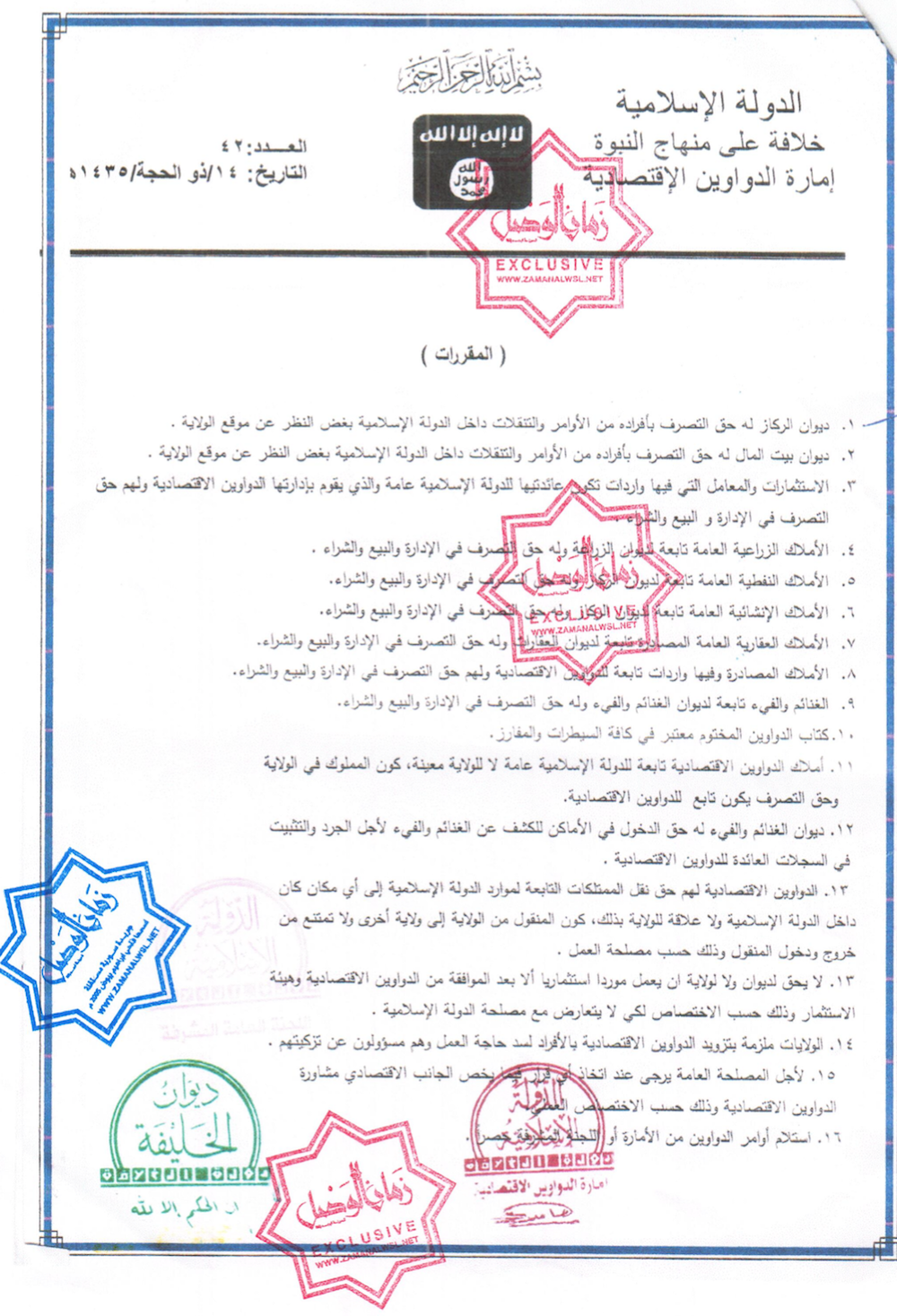
Zaman al-Wasl managed to obtain new and sensitive documents that practically explain the most important resources the Islamic State depended on, their methods to control, obtain and manage resources. Zaman al-Wasl will analyze the detailed documents which cover the period extending from mid-2015 to the beginning of 2016. The documents concern the Islamic State’s resources in resources in areas such as the states of Aleppo, al-Raqqah, and al-Jazira.
These documents offer insight to the shortcomings of previous studies on the Islamic State’s economy, especially those discussing the Islamic State’s structure and the actors responsible for managing its economy.
The studies including the research by Hasan Abu Haniyeh regarding the Islamic State’s organizational structure. He said that running the Islamic State’s economy was the job of the Beit al-Mal (Treasury), a historical Islamic term for a financial institution. The documents obtained by Zaman al-Wasl, indicate that the primary actor responsible for the economic sector is the Economic Diwans Emirate which is directly subordinate to the Caliphate Diwan under the leadership of Abu Bakr al-Baghdadi.
The Economic Diwans Emirate’s decisions include the seal of the prince of the Economic Diwans and, to the left of his seal, the seal of the Caliphate Diwan. The institution’s position within the hierarchy explains the nature of the institution. Beit al-Mal (Treasury) is one of the diwans subordinate to the Economic Diwans Emirate, and it is not a directive authority. Other than the treasury, the Economic Diwans Emirate includes several other diwans: Rukaz (treasures), agriculture, treasury, real estate, spoils, and bounty.
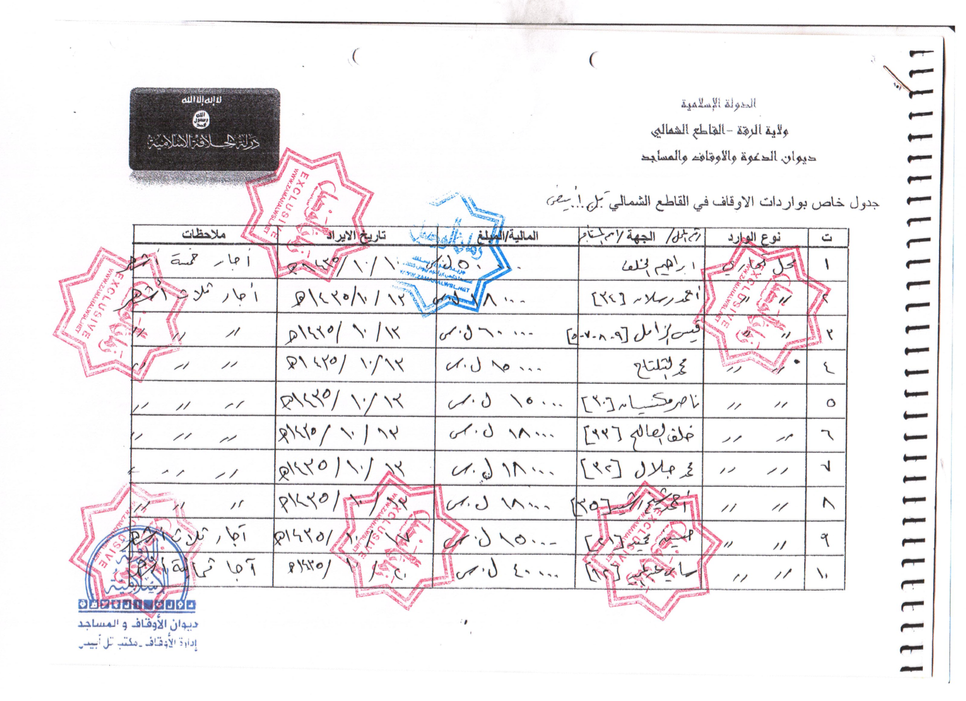
The Economic Diwans Emirate control resources and manage them based on directive instructions to the subsidiary Economic Diwans distributed across the areas under Islamic State control. The distribution of power highlights that the Caliph’s authority is not only religious or political but also economic as the Caliph interferes in the executive decisions on economy, money and resources.
The documents also show the existence of another actor involved in running the Islamic State’s economy called the Investment Committee. The Committee is concerned with legislating investment projects that secure the Islamic State’s resources in parallel to and in coordination with the Economic Diwans Emirate.
It is not clear the degree of its subordination to the Economic Diwans, and this indicates that the Islamic State benefitted from the experiences of modern states. Bodies such as the Committee are managed separately to the economic administrations which administer more bureaucratic and detailed issues and transactions. Perhaps it indicates an attempt to keep investments away from the control of these administrations and give a modern appearance to the Islamic State’s institutions.
It appears that there are attempts to separate between the authorities of the State and the Diwans subordinate to it which bestow upon the Caliph absolute centralized power on issues of primary importance including the economy, the Islamic State’s nervous system.
Among the documents Zaman al-Wasl obtained, is an important document outlining the financial and economic affairs and intricacies of the Islamic State. The document is an administrative decree issued by the Caliphate Diwan, and it is authorized by the seal of the highest authority within the Islamic State, represented by the Caliph Abu Bakr al-Baghdadi.
The document explains the nature of relations between the diwans and their relations with the states (provinces under Islamic State control), the possible interventions, and the mechanisms to untangle economic overlap. The document dated 14 Dhu al-Hjjah 1435 (9 October 2014), includes several articles concerned with taxation, the State’s petrol resources, real estate and investments, money from spoils and bounty, and financial management between the center and the states.
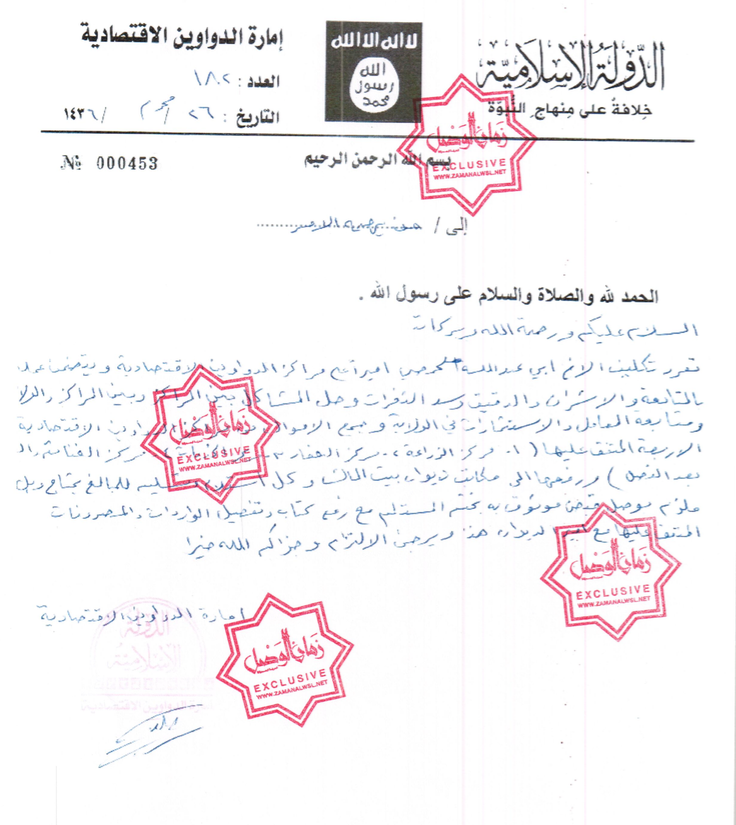
A Conflict of Center and States
The principle document sealed by the stamp of the Economic Diwans Emirate, the Caliphate Diwan, and the Joint General Committee in the Islamic State, shows the level of interaction and competition between the two principle sides one represented in the political and economic center, and the other in the branches represented by the states. It appears that the two sides were struggling over power and control of the Islamic State’s resources. The document includes 16 decisions through which the Caliphate Diwan tries to retain control over resources using the Economic Diwans Emirate. In the first and second articles, the Rukaz Diwan and the Treasury (Beit al-Mal) are given the right to dispose of their employees and transferrable assets as they see fit, “within the Islamic State regardless of the state’s location.”
The third article says that the investments and factories, “that are profitable, their revenues will be for the general Islamic State,” and the Economic Diwans have the right to manage them, engage in sales and purchase.
In the remaining decisions, the Economic Diwans (Rukaz, Agriculture, Real Estate, Spoils and Bounty) are given priority in disposing of assets according to their specializations. The diwans’ assets belong to the State and “not to a particular state,” and the article confirms diwans’ ownership of these assets.
Changing Variables
Analyzing the newly obtained Islamic State financial documents intersects with several studies and researches about the Islamic State’s resources and financial sources, but these documents reveal much more regarding the nature of these sources.
According to a report entitled, ‘Financing the Terrorist Organization, Islamic State in Iraq and Levant (ISIL)’, the primary financial sources available to the Islamic State are the banks the state gained control of, gas and oil reserves, imposing taxes on civilians, extortion, theft, and ransom money. The report adds assistance from non-profit organizations, foreign support and equipment made available to Islamic State fighters, and obtaining capital through modern communication networks.
The report prepared by the Financial Action Task Force, an international body specialized in issues of funding extremism, fails in include significant details about the sources of money.
It is restricted to presenting a political security perspective without offering sufficient insight into the Islamic State’s economic security. Also, the report does not recognize the evolution of the Islamic State, administratively and economically, since it was established as the State has gained practical experience in managing various and broad economic sectors and lands across 70,000 kilometres squared. The size of areas under their control increase and decrease according to the situation and confrontations in Syria and Iraq.
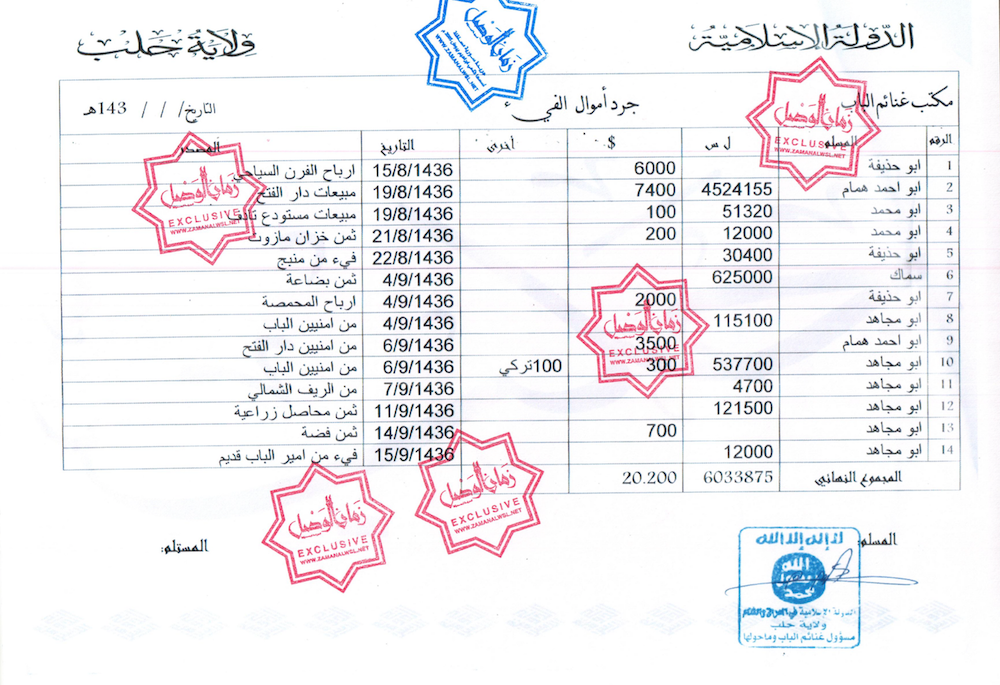
Professional Accounting System
The Islamic State uses advanced accounting database systems. In Syria, the state uses the local currency (Syrian pound) and US dollar.
It is possible to conclude based on the numbers and details listed in the documents that the Islamic State uses the most advanced methods to categorize, bill, and audit. The documents show a high level of transparency in defining the size of revenues, expenditures and their derivatives. This is a sign of the advanced nature of the Islamic State’s accounting and financial monitoring system, and the oversight of highly qualified professionals.
Principle Resources
To returning to document discussing the organizational relationshipes between the Economic Diwans and the states, it is possible to deduce that the most important financial resources available to the Islamic State are:
Finance Resources:
- Investments
- Farmlands
- Oil Revenues
- Constructions
- Real Estate
- Confiscated Properties
- Spoils
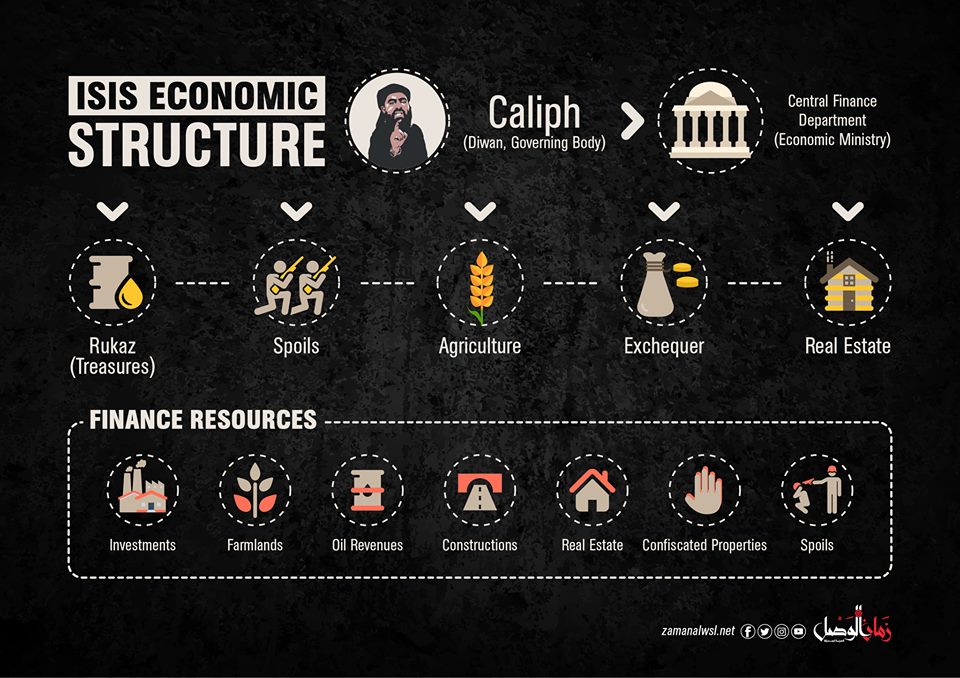
It does not appear that the remaining resources mentioned by previous studies and reports including donations, gifts, or ransom for releasing kidnapped foreigners, actually enter into the Islamic State’s calculations. This may indicate that considering these resources principle economic factors has perhaps changed, or it no longer enters into the advanced institutional framework mode of thinking within the Islamic State. The lack of emphasis on those sources of money is not surprising as the evolution of the Islamic State’s economic order depends on the State’s fifteen-years’ experience since Abu Mousab al-Zarkawi began building funding networks and establishing committees to gather finances with the foundation of the “Jama’at al-Tawhid wal al-Jihad” (Congregation of Monotheism and Jihad). The economic evolution and refinement of the tools of economic governance continued with the establishment of the Islamic State of Iraq and its first ministries in 2006, and its second set of ministries in 2009 which included ministries for oil and finances.
Oil Revenues
In one area called the “al-Barakah Province” (Blessed Province) the financial datasets concerning the oil investment budget in this single geographical space show that there are three locations or fields managed by the Islamic State including, Qabiyet, al-Farof, and al-Tawqaji which are subordinate to the Rukaz Diwan, oil and gas division. This small area generated revenue reaching 150,000 US Dollars during the month of Dhu al-Qa’dah 1436 Hijri (between August and September 2015). The numbers indicate that the Islamic State’s capabilities and its oil production in Syria where greatly and systematically exaggerated. It is not clear how much this sector was affected by the “Tidal Wave 2” Coalition operation targeting the stations, oil wells, and transportation tankers under Islamic State control. However, some of the purchase bills leaked with the other documents obtained by Zaman al-Wasl have dates close to the dates of the Coalition operations. These purchase bills are machine and drill parts used to produce and extract oil were used.
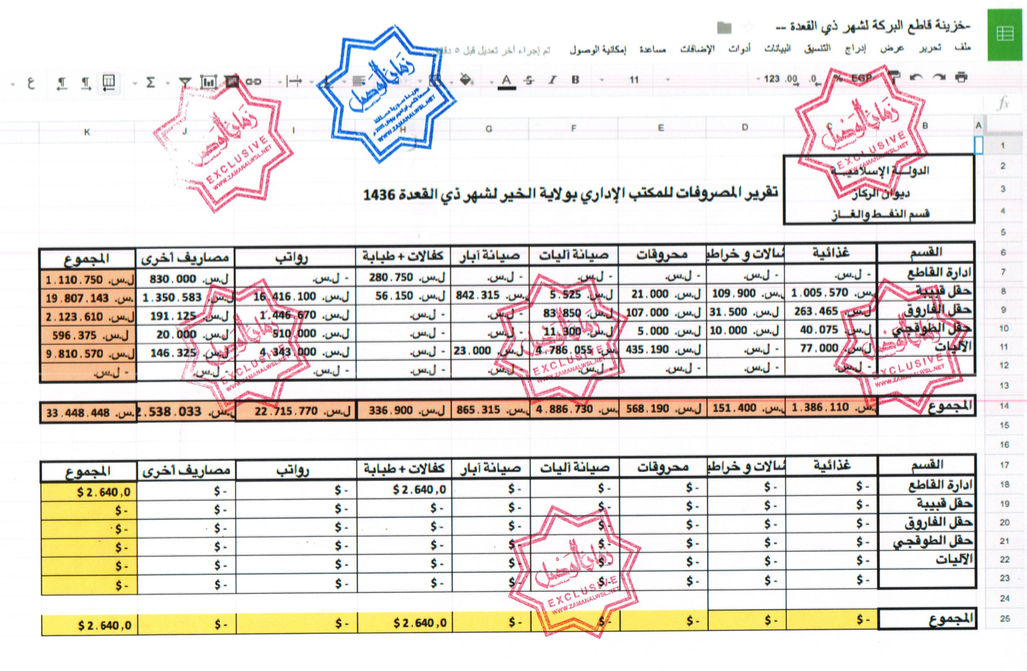
Some studies indicate that the Islamic State controls around 27 oil wells in Syria, half of which are in Deir Ez Zor province. Its general annual revenues from this sector in Iraq and Syria reached 400 million US dollars in 2015 while in 2014 it was around 1 billion US dollars. The data available shows an exaggeration of the size of revenue obtained by the Islamic State. This reduction in revenue prompted it to look for other revenue generating sources.
However, it is certain that oil production is greatly affected by the Coalition campaign as the Islamic State depended on selling most of the quantities extracted as ‘raw’ material because it lost its ability to refine the extracted oil. Refine oil generates higher revenues. The Islamic State sells the raw oil using intermediaries in areas under regime force control or opposition faction control. The Islamic State’s inability to refine oil is confirmed by the increase in the number of primitive oil refineries that appeared in these areas in the recent period.
Spoils, Second Largest Resource
Other documents focus on spoils money in Aleppo state dated to mid-2015. It appears clear that the Islamic State’s revenue from non-oil related sources is no less significant. The document shows varied commercial and trading activities including bakeries, food product warehouses, agricultural production, and financial sums obtained from treasurers in the areas subordinate to the states.
These treasures collect money which is mostly money confiscated from civilians, or paid in fines incurred as a result of court decisions. The document shows that the situation is more complicated as the Islamic State while forming a network of alternative resources cannot move away from the parasitic economic model. The Islamic State has not reached the stage of owning factories and strategic economic institutions for reasons relating to its security situation, the intense pressure it faces from different sides and on various fronts.
These factors force it to continue relying on a system dependent on mid or small sized institutions in addition to renting out the properties, buildings, warehouses, real estate, institutions it controls.
The Islamic State benefits from the revenue generated from rent to supplement the treasury, fund its large army’s salaries, and its religious institutions’ employees represented in thousands of employees working in proselyting and as religious police in addition to administrative staff and other sectors such as education and media.
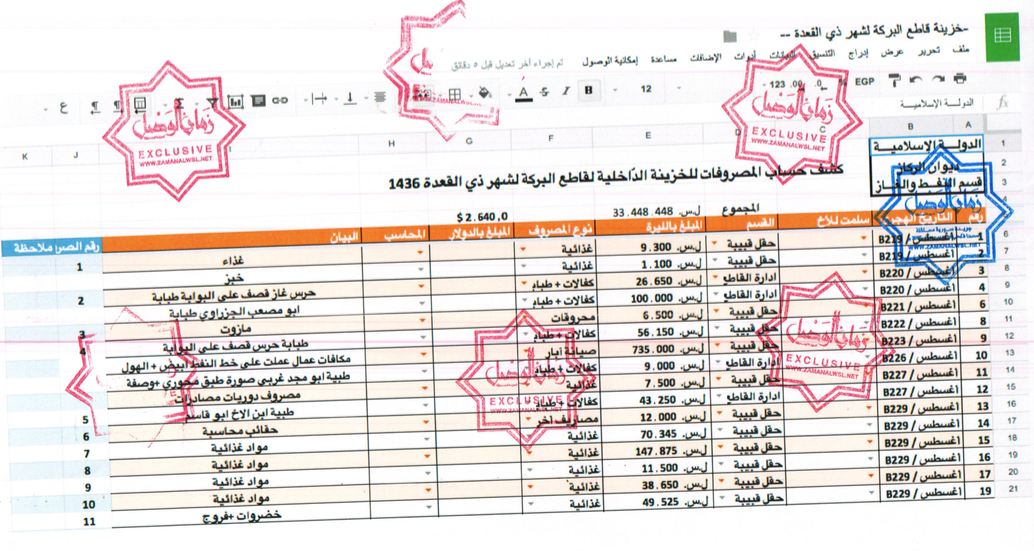
Most of the studies concentrated on the generalities of the resources that feed the Islamic State’s economy extending over vast parts of Syria and Iraq. Intelligence actors estimated that after taking control of Mosul, the Islamic State’s budget reached around one billion US dollars as the Islamic State took hold of important oil locations and confiscated tens of millions of US dollars from the Iraqi state treasury.

Zaman al-Wasl managed to obtain new and sensitive documents that practically explain the most important resources the Islamic State depended on, their methods to control, obtain and manage resources. Zaman al-Wasl will analyze the detailed documents which cover the period extending from mid-2015 to the beginning of 2016. The documents concern the Islamic State’s resources in resources in areas such as the states of Aleppo, al-Raqqah, and al-Jazira.
These documents offer insight to the shortcomings of previous studies on the Islamic State’s economy, especially those discussing the Islamic State’s structure and the actors responsible for managing its economy.
The studies including the research by Hasan Abu Haniyeh regarding the Islamic State’s organizational structure. He said that running the Islamic State’s economy was the job of the Beit al-Mal (Treasury), a historical Islamic term for a financial institution. The documents obtained by Zaman al-Wasl, indicate that the primary actor responsible for the economic sector is the Economic Diwans Emirate which is directly subordinate to the Caliphate Diwan under the leadership of Abu Bakr al-Baghdadi.
The Economic Diwans Emirate’s decisions include the seal of the prince of the Economic Diwans and, to the left of his seal, the seal of the Caliphate Diwan. The institution’s position within the hierarchy explains the nature of the institution. Beit al-Mal (Treasury) is one of the diwans subordinate to the Economic Diwans Emirate, and it is not a directive authority. Other than the treasury, the Economic Diwans Emirate includes several other diwans: Rukaz (treasures), agriculture, treasury, real estate, spoils, and bounty.

The Economic Diwans Emirate control resources and manage them based on directive instructions to the subsidiary Economic Diwans distributed across the areas under Islamic State control. The distribution of power highlights that the Caliph’s authority is not only religious or political but also economic as the Caliph interferes in the executive decisions on economy, money and resources.
The documents also show the existence of another actor involved in running the Islamic State’s economy called the Investment Committee. The Committee is concerned with legislating investment projects that secure the Islamic State’s resources in parallel to and in coordination with the Economic Diwans Emirate.
It is not clear the degree of its subordination to the Economic Diwans, and this indicates that the Islamic State benefitted from the experiences of modern states. Bodies such as the Committee are managed separately to the economic administrations which administer more bureaucratic and detailed issues and transactions. Perhaps it indicates an attempt to keep investments away from the control of these administrations and give a modern appearance to the Islamic State’s institutions.
It appears that there are attempts to separate between the authorities of the State and the Diwans subordinate to it which bestow upon the Caliph absolute centralized power on issues of primary importance including the economy, the Islamic State’s nervous system.
Among the documents Zaman al-Wasl obtained, is an important document outlining the financial and economic affairs and intricacies of the Islamic State. The document is an administrative decree issued by the Caliphate Diwan, and it is authorized by the seal of the highest authority within the Islamic State, represented by the Caliph Abu Bakr al-Baghdadi.
The document explains the nature of relations between the diwans and their relations with the states (provinces under Islamic State control), the possible interventions, and the mechanisms to untangle economic overlap. The document dated 14 Dhu al-Hjjah 1435 (9 October 2014), includes several articles concerned with taxation, the State’s petrol resources, real estate and investments, money from spoils and bounty, and financial management between the center and the states.

A Conflict of Center and States
The principle document sealed by the stamp of the Economic Diwans Emirate, the Caliphate Diwan, and the Joint General Committee in the Islamic State, shows the level of interaction and competition between the two principle sides one represented in the political and economic center, and the other in the branches represented by the states. It appears that the two sides were struggling over power and control of the Islamic State’s resources. The document includes 16 decisions through which the Caliphate Diwan tries to retain control over resources using the Economic Diwans Emirate. In the first and second articles, the Rukaz Diwan and the Treasury (Beit al-Mal) are given the right to dispose of their employees and transferrable assets as they see fit, “within the Islamic State regardless of the state’s location.”
The third article says that the investments and factories, “that are profitable, their revenues will be for the general Islamic State,” and the Economic Diwans have the right to manage them, engage in sales and purchase.
In the remaining decisions, the Economic Diwans (Rukaz, Agriculture, Real Estate, Spoils and Bounty) are given priority in disposing of assets according to their specializations. The diwans’ assets belong to the State and “not to a particular state,” and the article confirms diwans’ ownership of these assets.
Changing Variables
Analyzing the newly obtained Islamic State financial documents intersects with several studies and researches about the Islamic State’s resources and financial sources, but these documents reveal much more regarding the nature of these sources.
According to a report entitled, ‘Financing the Terrorist Organization, Islamic State in Iraq and Levant (ISIL)’, the primary financial sources available to the Islamic State are the banks the state gained control of, gas and oil reserves, imposing taxes on civilians, extortion, theft, and ransom money. The report adds assistance from non-profit organizations, foreign support and equipment made available to Islamic State fighters, and obtaining capital through modern communication networks.
The report prepared by the Financial Action Task Force, an international body specialized in issues of funding extremism, fails in include significant details about the sources of money.
It is restricted to presenting a political security perspective without offering sufficient insight into the Islamic State’s economic security. Also, the report does not recognize the evolution of the Islamic State, administratively and economically, since it was established as the State has gained practical experience in managing various and broad economic sectors and lands across 70,000 kilometres squared. The size of areas under their control increase and decrease according to the situation and confrontations in Syria and Iraq.

Professional Accounting System
The Islamic State uses advanced accounting database systems. In Syria, the state uses the local currency (Syrian pound) and US dollar.
It is possible to conclude based on the numbers and details listed in the documents that the Islamic State uses the most advanced methods to categorize, bill, and audit. The documents show a high level of transparency in defining the size of revenues, expenditures and their derivatives. This is a sign of the advanced nature of the Islamic State’s accounting and financial monitoring system, and the oversight of highly qualified professionals.
Principle Resources
To returning to document discussing the organizational relationshipes between the Economic Diwans and the states, it is possible to deduce that the most important financial resources available to the Islamic State are:
Finance Resources:
- Investments
- Farmlands
- Oil Revenues
- Constructions
- Real Estate
- Confiscated Properties
- Spoils

It does not appear that the remaining resources mentioned by previous studies and reports including donations, gifts, or ransom for releasing kidnapped foreigners, actually enter into the Islamic State’s calculations. This may indicate that considering these resources principle economic factors has perhaps changed, or it no longer enters into the advanced institutional framework mode of thinking within the Islamic State. The lack of emphasis on those sources of money is not surprising as the evolution of the Islamic State’s economic order depends on the State’s fifteen-years’ experience since Abu Mousab al-Zarkawi began building funding networks and establishing committees to gather finances with the foundation of the “Jama’at al-Tawhid wal al-Jihad” (Congregation of Monotheism and Jihad). The economic evolution and refinement of the tools of economic governance continued with the establishment of the Islamic State of Iraq and its first ministries in 2006, and its second set of ministries in 2009 which included ministries for oil and finances.
Oil Revenues
In one area called the “al-Barakah Province” (Blessed Province) the financial datasets concerning the oil investment budget in this single geographical space show that there are three locations or fields managed by the Islamic State including, Qabiyet, al-Farof, and al-Tawqaji which are subordinate to the Rukaz Diwan, oil and gas division. This small area generated revenue reaching 150,000 US Dollars during the month of Dhu al-Qa’dah 1436 Hijri (between August and September 2015). The numbers indicate that the Islamic State’s capabilities and its oil production in Syria where greatly and systematically exaggerated. It is not clear how much this sector was affected by the “Tidal Wave 2” Coalition operation targeting the stations, oil wells, and transportation tankers under Islamic State control. However, some of the purchase bills leaked with the other documents obtained by Zaman al-Wasl have dates close to the dates of the Coalition operations. These purchase bills are machine and drill parts used to produce and extract oil were used.

Some studies indicate that the Islamic State controls around 27 oil wells in Syria, half of which are in Deir Ez Zor province. Its general annual revenues from this sector in Iraq and Syria reached 400 million US dollars in 2015 while in 2014 it was around 1 billion US dollars. The data available shows an exaggeration of the size of revenue obtained by the Islamic State. This reduction in revenue prompted it to look for other revenue generating sources.
However, it is certain that oil production is greatly affected by the Coalition campaign as the Islamic State depended on selling most of the quantities extracted as ‘raw’ material because it lost its ability to refine the extracted oil. Refine oil generates higher revenues. The Islamic State sells the raw oil using intermediaries in areas under regime force control or opposition faction control. The Islamic State’s inability to refine oil is confirmed by the increase in the number of primitive oil refineries that appeared in these areas in the recent period.
Spoils, Second Largest Resource
Other documents focus on spoils money in Aleppo state dated to mid-2015. It appears clear that the Islamic State’s revenue from non-oil related sources is no less significant. The document shows varied commercial and trading activities including bakeries, food product warehouses, agricultural production, and financial sums obtained from treasurers in the areas subordinate to the states.
These treasures collect money which is mostly money confiscated from civilians, or paid in fines incurred as a result of court decisions. The document shows that the situation is more complicated as the Islamic State while forming a network of alternative resources cannot move away from the parasitic economic model. The Islamic State has not reached the stage of owning factories and strategic economic institutions for reasons relating to its security situation, the intense pressure it faces from different sides and on various fronts.
These factors force it to continue relying on a system dependent on mid or small sized institutions in addition to renting out the properties, buildings, warehouses, real estate, institutions it controls.
The Islamic State benefits from the revenue generated from rent to supplement the treasury, fund its large army’s salaries, and its religious institutions’ employees represented in thousands of employees working in proselyting and as religious police in addition to administrative staff and other sectors such as education and media.

















Comments About This Article
Please fill the fields below.